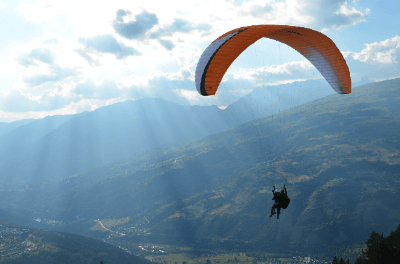What Is a Paraglider?

A paraglider refers to the complete set of equipment used for flying in the sky sport of paragliding.
With a wing (canopy) that floats on the wind, pilots can take off from the ground using their legs and soar through the air. In recent years, its charm has gained popularity, enjoyed as a hobby, and practiced as a competitive sport.
It is also classified as one of the categories of hang gliders by the Fédération Aéronautique Internationale (FAI).
Uses of Paraglider
Paragliders are primarily used for the following purposes:
1. Recreation and Tourism
Paragliders, capable of leisurely flying through the air, are enjoyed by many. With practice, pilots can improve their skills, mastering takeoff and landing maneuvers. Flying while enjoying the scenery makes it a recommended activity for those who want to appreciate nature.
Paragliding experiences in tourist destinations are also popular. Especially in areas with mountains or close to the sea, one can enjoy the beautiful scenery from the sky. Tandem flights with instructors are available, ensuring a safe experience for beginners.
2. Competition
Paragliding competitions are held domestically and internationally, featuring races based on distance and altitude, with advanced-level competitions available. Relay races with teams participating are also organized, providing an opportunity for friends to enjoy the sport together.
3. Photography and Videography
Paragliders offer the ability to capture images from the air, allowing for the enjoyment of beautiful landscapes and thrilling angles. While drone aerial photography is popular, using a paraglider enables a more natural movement and perspective.
Many individuals also share their airborne experiences by uploading photos and videos to social media and video-sharing platforms.
Structure of Paraglider
A paraglider is mainly composed of the following parts:
1. Canopy
The canopy is the wing part of the paraglider, constructed from lightweight and durable nylon fabric. The fabric undergoes coating treatment to reduce air permeability. Inside, there is a structure of small cells, and as air flows through, the wing inflates, generating lift.
2. Harness
The harness is the part where the pilot sits and is worn on the body. It includes straps on the shoulders and legs, ensuring the pilot can fly safely. Additionally, harnesses commonly have a reserve parachute for emergencies.
3. Lines
Lines connect the canopy to the harness and play a role in altering the shape of the canopy. Multiple lines allow pilots to control gliding speed and turn, providing control over the paraglider.
Principle of Paraglider
The principle behind paraglider flight is the result of the relationship between the shape of the wing (canopy) and the flow of air. Air enters through the air intake at the front edge of the canopy, and within the enclosed wing, pressure builds up, causing the canopy to spread into the shape of a wing.
Due to the expanded canopy, a difference in speed occurs between the upper and lower surfaces of the wing, generating lift perpendicular to the wing. This lift allows the paraglider to ascend.
The canopy has a rounded leading edge, making it prone to differences in airspeed between the upper and lower surfaces, enhancing the generation of lift. Additionally, riding thermal updrafts enables maintaining altitude or climbing even higher.
Other Information on Paraglider
History of Paraglider
The precursor to the paraglider is the paraplane, a flexible wing designed by Domina Jalbert in 1964. In April 1966, mountaineer Yuichiro Miura descended Mount Fuji using a square parachute as a brake, catching the attention of sports enthusiasts and leading to the consideration of its application in sports.
The practical use of paragliding as a sport began around 1978 when a French skydiver descended from a mountain slope using a square parachute.